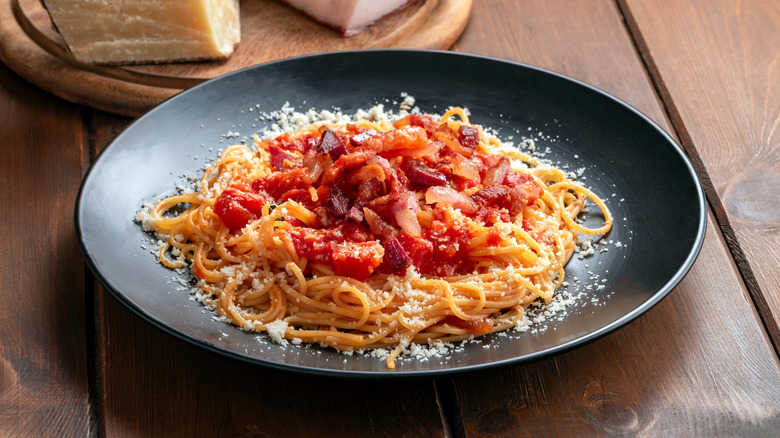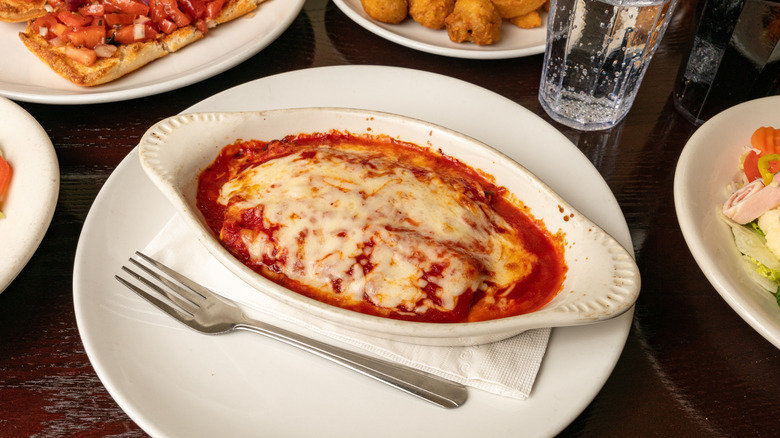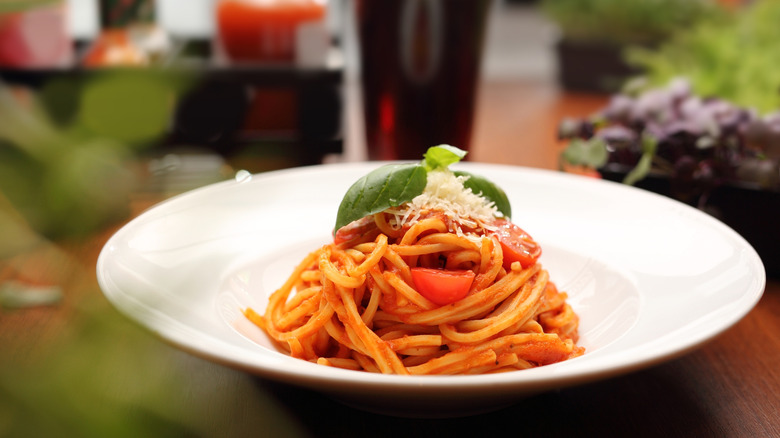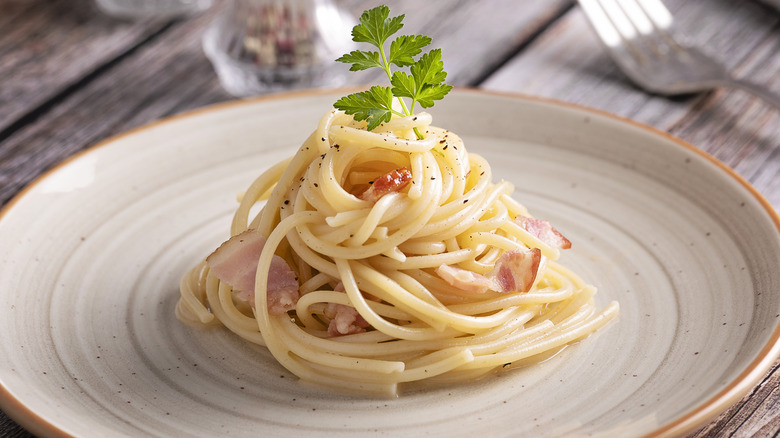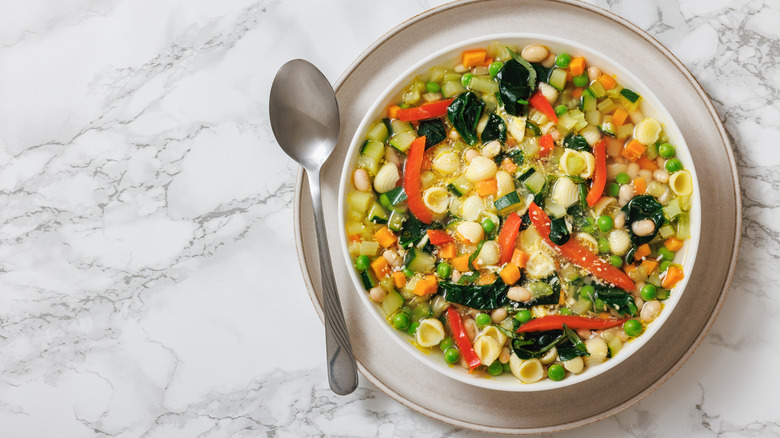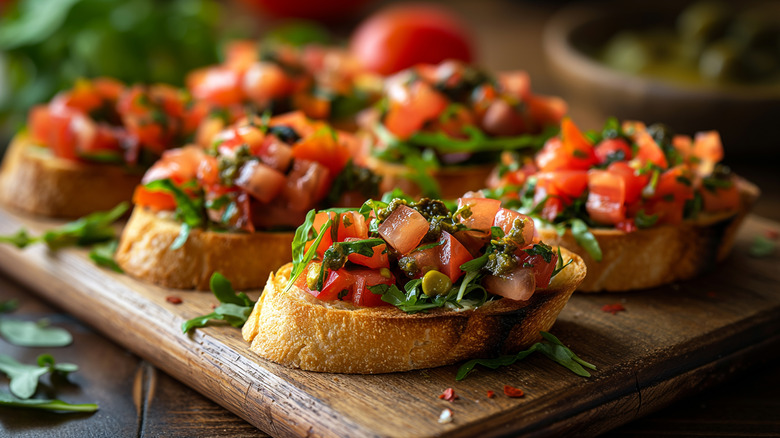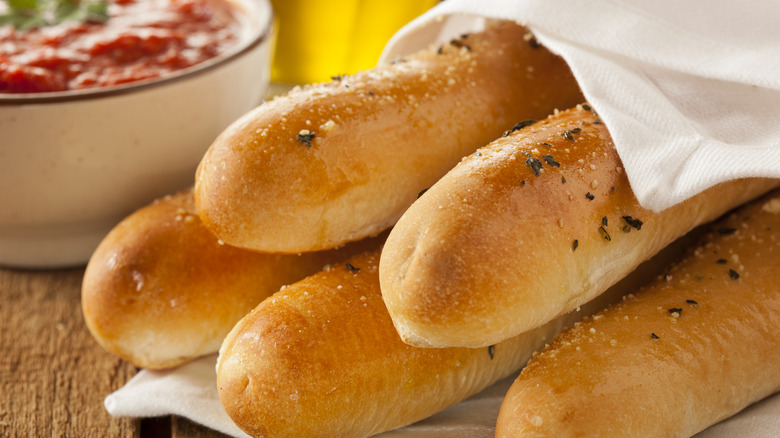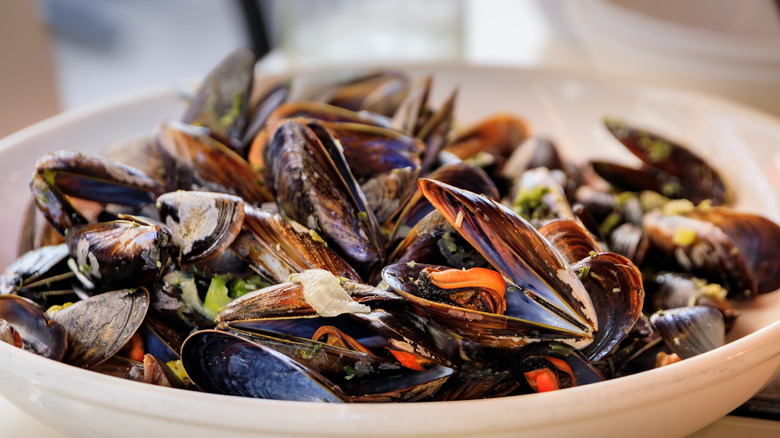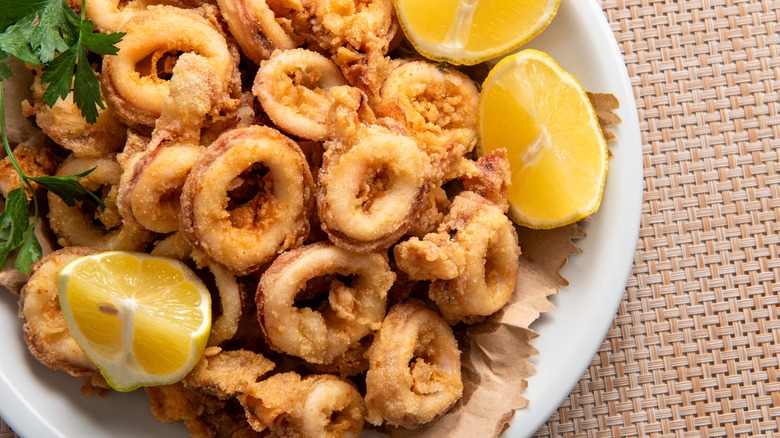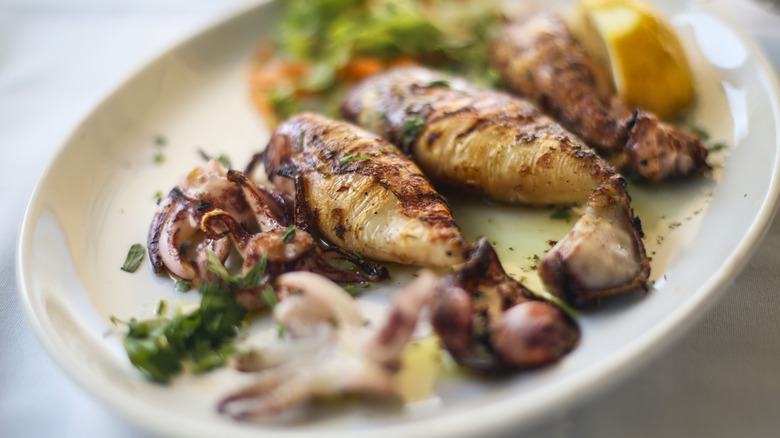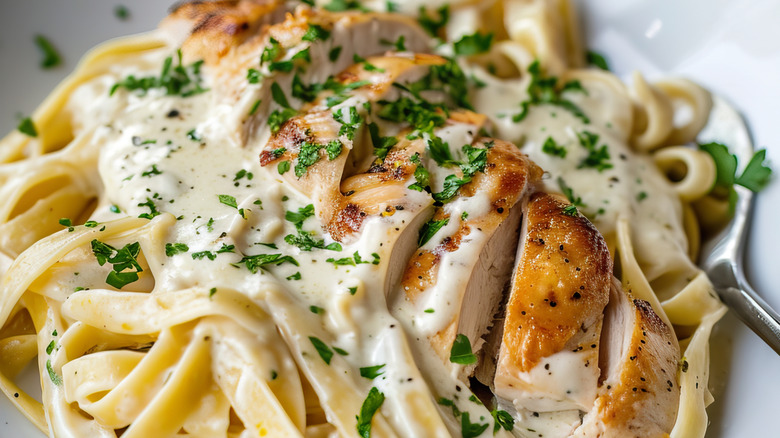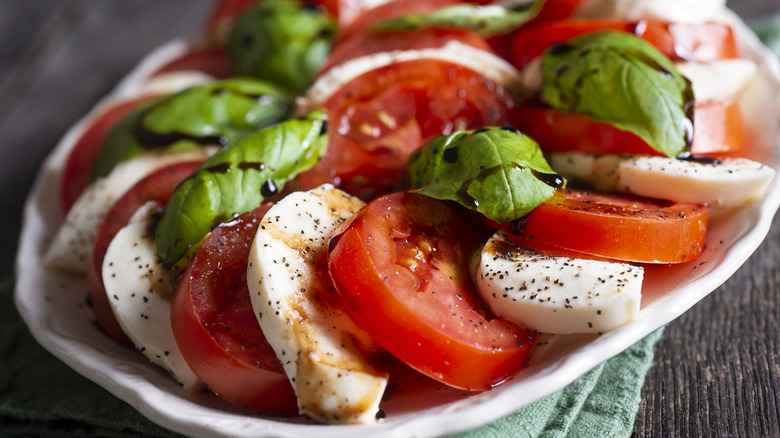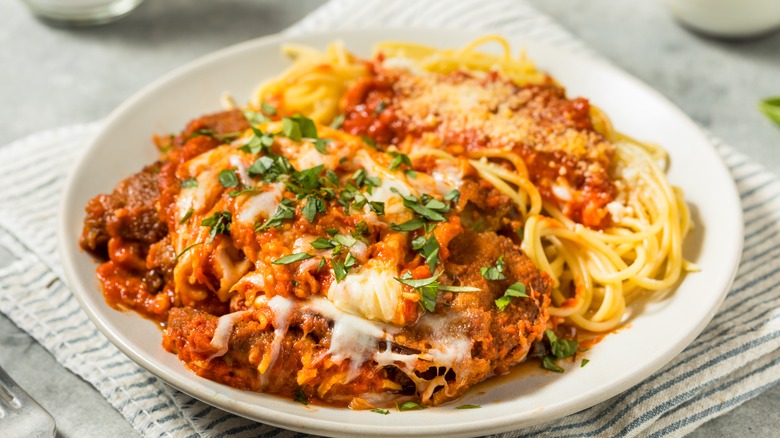8 Unhealthiest And 6 Healthiest Items To Order At An Italian Restaurant
Even though the Mediterranean diet is often praised as one of the healthiest diets that you could follow, you'll likely need to look far and wide to find a dietitian or nutritionist who will tell you to eat Italian all day, every day. Italian food — or at least the Americanized Italian food served at chains like Olive Garden and Fazoli's — is notoriously carby, fatty, and sodium-filled. After all, as delicious as it is, that's just what you get when you combine a lot of pasta and a lot of cheese.
If you're trying to limit your overindulgence and maybe watch what you eat, then do you have to give up dining at Italian chains overall? Not in the slightest! There are still some relatively healthy items you can find on most menus. However, there are also some menu items that you should definitely avoid if you're trying to eat moderately healthfully for the day. These are some of the unhealthiest and healthiest items you can order at an Italian restaurant.
Unhealthiest: Stuffed pasta
We all love stuffed pasta, right? Shells? Manicotti? But unfortunately, stuffed pastas are typically stuffed with more than just a delightful mixture of cheeses.
For example, Olive Garden's manicotti, which comes in both a four-cheese and three-meat variant, is topped with marinara and melted mozzarella, and it looks pretty benign. However, those stuffed noodles also come with either 710 or 1,060 calories in a dinner entrée portion, depending on if you ordered the four-cheese or three-meat option, respectively, plus either 2,060 or an eye-watering 3,180 milligrams of sodium. You're also getting either 18 or 21 grams of sugar, likely from the pasta sauce.
If these numbers mean nothing to you at first glance, consider that the American Heart Association recommends you ideally eat no more than 1,500 milligrams of sodium per day, and a three-meat serving of manicotti at Olive Garden gives you double that. Then, think of a gram of sugar as about a fourth of a teaspoon of sugar — meaning eating the three-meat manicotti is roughly equivalent to eating five teaspoons of sugar.
Healthiest: Spaghetti marinara or pomodoro
While pasta, in general, can sometimes get a bad rep, don't feel like you have to avoid it just because it's a carb. Pasta can be entirely a part of a well-balanced diet. Picking the right pasta when you go out to eat at an Italian chain restaurant, though, can be crucial to meeting your individual health goals.
Regardless of what those health goals are, though, you should feel confident ordering either the spaghetti marinara or pomodoro. Both of these dishes are basically pasta with tomato sauce, but they'll differ slightly, and many restaurants will either serve one or the other. In general, marinara sauce is thinner and pomodoro sauce is thicker, but both are very similar in terms of ingredients.
Bravo! Italian Kitchen's spaghetti pomodoro has the least calories, fat, sodium, and cholesterol out of all the chain's pasta options, and by a long shot. Meanwhile, nearly the same can be said at Carrabba's Italian Grill, with the spaghetti pomodoro ranking in the top three lowest-calorie pasta options on the menu while boasting the least fat and no cholesterol at all.
Unhealthiest: Carbonara
Carbonara is a relatively simple pasta dish that just about anyone can make. It's pasta, eggs, cheese, and bacon. Sometimes, the restaurant might add on another protein. Not too bad, right? Well, looks can be deceiving.
Take Olive Garden's chicken and shrimp carbonara, for example. While this menu item does have fewer calories than many others on the Olive Garden pasta menu, it also comes with a hefty 91 grams of fat, including 47 grams of saturated fat and 25 grams of trans fat. There are also 390 milligrams of cholesterol and 2,050 milligrams of sodium. Remember, also, that you're not really supposed to be eating trans fat at all, so 25 grams is quite a lot.
Fazoli's, meanwhile, offers a chicken carbonara that's similar in terms of calories and actually has half the fat. However, it also has way more sodium, at 3,370 milligrams of sodium in a serving. As such, if you're watching either your fat or sodium intake, you'd probably do well to avoid carbonara of all kinds on most menus.
Healthiest: Minestrone
Soup is often a healthful pick on many restaurant menus, so long as you avoid potentially sodium-rich soups like French onion, or heavy, dairy-based soups like chowders. Minestrone fits the bill, with its healthful mix of vegetables, beans, and pastas, in a clear broth.
At Carrabba's Italian Grill, the minestrone soup is your healthiest soup option, with fewer calories, less fat, less cholesterol, less sodium, and less sugar than any other soup option per serving, tying for the least sugar with the Sicilian chicken soup. Similarly, at Johnny Carino's, the minestrone soup has fewer calories and far less fat than the roasted garlic and potato soup, though it does have slightly more sodium, but just by a smidge. At Olive Garden, the menu reveals much of the same, with the minestrone, one of the chain's best soups, outshining its Zuppa Toscana, pasta fagioli, and chicken and gnocchi soup easily, again, with just a slightly higher amount of sodium than some of the others, at 810 milligrams per serving. While that number certainly doesn't make the soup a low-sodium option, it's much more palatable than the 1,290 milligrams of sodium that you'll find in Olive Garden's chicken and gnocchi soup.
Unhealthiest: Fried mozzarella
At many Italian restaurants, fried mozzarella is a staple appetizer. It's not always mozzarella sticks per se. Sometimes, the restaurant tries to fancy up its fried mozzarella by serving it to you in a shape that's not a cylinder — but the spirit's the same.
However, like most deep-fried foods, fried mozzarella is not going to be the healthiest appetizer on an Italian chain's menu. At Olive Garden, the fried mozzarella is a crowd favorite, but it comes with 1,990 milligrams of sodium per serving, well over your daily recommended allotment. Meanwhile, the app comes with 49 grams of total fat, including 17 grams of saturated fat. It's advised that you refrain from eating more than 20 to 30 grams of saturated fat per day, so if you order this appetizer and are trying to stay within the recommended limits, you'll almost be at your cap. The mozzarella sticks at Johnny Carino's fare a little better, with a regular serving coming with a whopping 2,195 milligrams of sodium plus trans fat.
Healthiest: Bruschetta
If you want a healthier appetizer, consider bruschetta. Fresh, light, and quintessentially Italian, bruschetta is typically just bread topped with a mix of tomatoes, olive oil, and basil. While you might want to watch overall how much bread and olive oil you eat, and bruschetta isn't without its faults (you'll find that it can often come with more sugar than other apps), this appetizer is definitely going to be one of your overall best options on most Italian chains' menus.
At Carrabba's Italian Grill, the bruschetta, which is available regionally, comes with the least sodium out of all appetizers on the chain's menu. It also has comparatively less saturated fat than other starters. At Brio Italian Grille, the bruschetta sampler likewise has fewer calories than the majority of appetizers, as well as less sodium than the majority. Again, though, keep in mind that bruschetta can sometimes have more sugar than other appetizers, so if you're specifically trying to reduce your sugar intake, that's worth considering before you place your order.
Unhealthiest: Breadsticks
Yes, the glories of the Olive Garden breadstick have long been a thing of internet discussion, and even Fazoli's never-ending breadsticks have likewise gained their spot in chain-food fame. However, just because you can eat endless breadsticks doesn't mean that you should eat endless breadsticks.
Olive Garden's breadsticks with the classic garlic topping are 140 calories each, with 2.5 grams of fat and 460 milligrams of sodium each. While the relatively low caloric content means that you could eat several breadsticks and still be eating fewer calories than you might when ordering another one of the chain's appetizer options, that sodium really adds up, and if you eat four breadsticks, you're over your recommended sodium intake for the day.
Meanwhile, at Fazoli's a signature garlic breadstick comes with 145 calories, as well as 7.5 grams of fat and 335 milligrams of sodium. While this is a little better than Olive Garden's breadsticks in terms of sodium, if not in terms of fat, it's still something to keep in mind if your first inclination at an Italian chain is to challenge yourself to eat as many breadsticks as humanly possible.
Healthiest: Mussels
While it's not an option at every Italian restaurant (you're certainly not going to find mussels on the menu at Fazoli's), if you can find them, they can be one of your more nutritious options. Mussels come with lots of protein and, depending on the exact recipe, might be tossed only in a light olive oil or butter sauce. Additionally, eating mussels is an experience that encourages mindful eating, as you have to slow down and pry open each individual shellfish — making it more likely that you'll actually stop eating once you're full.
Italian chains that serve mussels include Il Fornaio and Carmine's. In general, you can expect steamed mussels to offer a low number of calories per serving, 20 grams of protein, and little in the way of fat and carbohydrates. Of course, depending on if the mussels are served with a butter or olive oil-based sauce, you'll add on a little fat and sodium, but you can avoid excessive fat and sodium by limiting sauce intake. Mussels are also sources of vitamins and minerals such as iron and vitamins C and A.
Unhealthiest: Fried calamari
On the unhealthy side of Italian seafood, fried calamari is one for the books. While it is seafood, which we typically think of as being on the healthier end, fried calamari is often breaded and deep-fried, and that adds on fat and calories.
At Carrabba's Italian Grill, the fried calamari with marinara and ricardo sauce is one of the highest-calorie appetizers on the menu, as well as one of the top appetizers for fat content. Only the restaurant's combo appetizer platters outrank the calamari in both categories. The calamari also come with 8 grams of trans fat, which you should avoid altogether, and 2,220 milligrams of sodium.
At Olive Garden, the story is somewhat more positive, but just barely. The chain's calamari is closer to the bottom of the pack when comparing Olive Garden apps by caloric content, but the calamari contains the most cholesterol out of any other appetizer on the menu, as well as 1,600 milligrams of sodium.
Healthiest: Grilled calamari
If you do have a hankering for calamari, though, all you have to do is swap out the fried calamari for grilled calamari, and you'll see a huge difference in nutritional value. Not many chains serve grilled calamari, unfortunately, but you can find it at Moretti's, a Chicago-based chain, as well as at non-chain Italian restaurants.
The main benefit of opting for grilled calamari versus fried calamari is that you'll skip all the added fat and calories that come with the deep-fried version. Thus, you'll be able to enjoy all the benefits of squid without the added fat. Benefits include 18 grams of protein per serving, plus iron, calcium, vitamin C, and omega-3 fatty acids. Plus, calamari are considered fish safe for pregnant individuals to eat. The only thing you might want to consider is that grilled calamari is often grilled in olive oil, which should be eaten in moderation, but olive oil is a far better alternative than the frying oil that the calamari may be cooked in otherwise.
Unhealthiest: Fettuccine Alfredo
This is probably one that you already guessed. Creamy, cheesy, carb-heavy fettuccine alfredo, whether you add on some chicken, veggies, or anything else, unfortunately, finds a spot among the unhealthiest menu items at most Italian restaurants. There are just very few ways to actually take this dish and make it healthy, as its essence is, more or less, fat and salt.
At Olive Garden, the chicken alfredo with grilled chicken comes with 95 grams of fat, 2 grams of trans fat, 2,290 milligrams of sodium, and 6 grams of sugar. If you upgrade to the chicken alfredo with crispy chicken, you add on about 20 more grams of fat and about 400 milligrams of sodium. Meanwhile, at Bravo! Italian Kitchen, the fettuccine alfredo is slightly more palatable, with 36 grams of fat and 1,690 milligrams of sodium, but that's still more sodium than you need in an entire day, in other words, forget the breadsticks on the side. Fazoli's fettuccine alfredo has even less fat, at 26 grams per serving, but even more sodium, at 1,820 milligrams.
Healthiest: Caprese salad
Like mussels or grilled calamari, Caprese salad isn't going to be a menu item that you find on every single chain Italian menu, but if you can find it, you'll be treated to a delicious, light, and healthful salad that's often as pretty to look at as it is to eat.
Bravo! Italian Kitchen serves a tomato caprese that's the lowest-fat salad option on the chain's menu. It's important to note that, while it contains less fat than any other salad at the restaurant, it does contain more saturated fat than the Caesar salad, as well as more sodium than the Caesar salad, though only marginally. Yet, the tomato caprese also has the least amount of carbs, while offering the second-greatest amount of protein.
Brio Italian Grille likewise offers a tomato caprese salad that provides the menu's second-least fat content (after the chopped salad, by one gram), the second-least sodium (after the Caesar salad), the least overall carbs, and the second-greatest amount of protein (after the wedge salad).
Unhealthiest: Eggplant Parm
Eggplant Parm is one of those sleeper menu items that you think will actually be healthier because its whole identity is wrapped up in being a vegetable. It's the go-to on many Italian menus for vegetarians. However, much as is the case with calamari, when you fry an eggplant, you're adding a lot of extra unhealthy ingredients that kind of negate the original ingredient's health benefits to a degree. In fact, if you're opting for the eggplant Parmesan instead of the chicken Parm because you think it'll actually be healthier, think again.
In truth, at Olive Garden, eggplant Parmigiana has more calories than chicken Parmigiana, and it has more fat, carbs, and sugar. That said, the eggplant Parm does contain much less sodium and more fiber than the chicken Parm, though the eggplant Parm's sodium per serving is still a jaw-dropping 2,440 milligrams, and the extra fiber you're getting from the eggplant is just 4 grams.
Unhealthiest: Cannoli
Lastly, when it's time to wrap up your meal, you may find yourself reaching for the dessert menu. Italian restaurants offer some truly delicious desserts, like cheesecake and tiramisu, but it's the cannoli that'll really get you when you don't expect it. They're cute. They can appear small and light, but they might not be the overall healthiest of desserts.
At Carrabba's Italian Grill, the traditional cannoli contain more calories than both the tiramisu and the John Cole (ice cream topped with pecans and caramel). Don't even think about the cannoli cake for two, which comes in with 2,170 calories. At least the traditional cannoli has the least sugar out of all the desserts on the menu.
More generally, the average cannoli comes with about 230 calories per serving, 15 grams of fat, and 6 grams of sugar. The sugar and ricotta all add up — but a cannoli can be a reasonable treat if the rest of your meal is lighter.
